Table of Contents
Introduction
In our previous articles, we have already discussed Natural Disasters like cyclones, earthquakes, etc. In this article, we are going to focus on another natural disaster i.e. Volcanic eruption. Here, we will cover What are volcanoes? How are volcanoes formed? What are the different types and features of volcanoes? And, how are the volcanic eruptions measured?
Volcanoes are one of the most fascinating and also destructive entities on Earth. A volcano eruption can both be a boon and a curse. Boon, because they are one of the core reasons for the formation of Earth’s surface on which we live. New ocean beds, islands, etc. can be created due to volcanic eruption. Curse, because Volcanic Eruptions that spew lava can destroy and burn anything and everything that comes in its way. It is very likely that if there is a severe volcanic eruption in a region, the people need to be evacuated to a safer place.
Volcanoes formed over the years of eruption appear like huge mountains. They have an opening (vent) at the top from where Volcanic Eruption happens. Volcano walls are created due to multiple eruptions of magma or lava over the years. The lava ultimately cools down and hardens when it reaches the surface of the earth. A volcanic eruption is treated as a Natural Disaster just like Earthquakes, Cyclones, Tornadoes, etc. as it can cause considerable damage to property, nature, and human life.
Some Statistics
It is estimated that there are almost 1,500 potentially active Volcanoes present today around the globe. And around 10% of these volcanoes are in and around the United States.
Ring of Fire: The Pacific Ring of Fire or Ring of Fire is a horseshoe-shaped belt in the Pacific Basin that consists of many active volcanoes and is also home to frequent seismic (earthquakes) activities. Almost 75% of the total active volcanoes are part of this belt. The belt is around 40,000 kilometers long and contains boundaries of many tectonic plates which are one of the primary reasons for volcano creation and earthquakes.
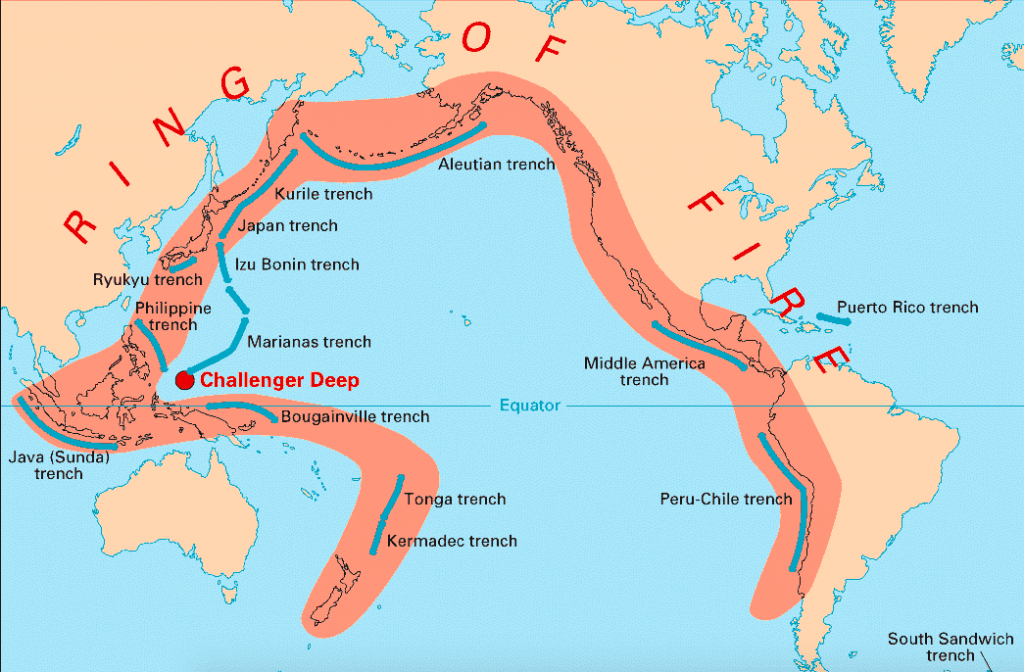
Image Source – pubs.usgs.gov
Layers of the Earth
The Volcanic Eruptions are related to the Mantle and the Crust layers of the Earth. A brief of these layers is available in our article Unraveling the basics of how do Earthquakes happen?
The mantle is the layer just below the Earth’s crust and is considered to be the thickest layer. It consists of molten rock or Magma and is semi-solid. The high temperature of the outer core is what leads to molten rock. The temperatures in this layer can reach 4,000 degrees Celsius. As only a part of the mantle becomes molten, the lighter magma rises above its rocky surrounding and reaches the crust. When the magma is spewed out of the crust, it is called a volcanic eruption.
The Crust is the outermost layer of the Earth with a thickness of around only 100 kilometers.
Volcanoes and how are volcanoes formed?
The volcanoes are openings in the Earth’s Crust that allow the escape of lava, volcanic ash, and gases. In simple terms, the volcanoes are formed when molten magma is expelled from the Earth’s crust due to the magmatic processes within the Earth’s surface.
Just like the movement of the tectonic plates causes Earthquakes, the tectonic plates are also the source of Volcanoes.
There are three ways how volcanoes can be formed:
How are volcanoes formed: Hotspot
A hotspot is a volcanic region (source of high heat energy) in the mantle from where a large amount of heat (thermal plume) is generated.
As thermal plume progresses towards the lithosphere (tectonic plates), due to the high temperature and variation in pressure, the base of the tectonic plates starts to melt. The molten magma produced then comes out through the narrow openings in the Crust causing a volcanic eruption. The Hotspots are independent of the tectonic plate boundaries. So, they can form anywhere on the tectonic plates.
Such kinds of hotspots are available in Hawaii, Iceland, and parts of the United States.
Due to the tectonic plates’ movement but a stationary hotspot, a chain of volcanoes could be formed. New volcanoes are formed above the hotspot and due to the plate movement. The thermal plumes may or may not move with the Tectonic Plates. This means that Volcanic Eruptions may or may not happen once they have moved away from the hotspot. Though, over time the Volcanoes (that have moved from the hotspot) become extinct due to erosion.
The Hawaiian Islands were supposedly formed using the same theory.
How are volcanoes formed: Divergent Boundary
There is a good probability of volcano formation when two tectonic plates move away from each other. This boundary is called a divergent boundary. The divergent boundary occurs due to the underlying convection currents that push the lithosphere and sometimes stretch it to the point that fissures are created. When a fissure is formed, the less dense magma rises to the Crust. If the magma does not cool down, it comes out of the Crust as Volcanic Eruption.
The magma that erupts out of the Volcano is called Lava. In most cases, the hardening of lava creates the flanks of Volcanoes.
How are volcanoes formed: Convergent Boundary
When two tectonic plates bump or collide with each other at their plate boundaries, it is called a convergent boundary. Volcanoes can be formed at the convergent boundary. This phenomenon is common between the Oceanic and the Continental plates, where the more dense but thinner Oceanic Plate gets subducted under the less dense but thicker Continental plate.
Once the subducted layer/plate reaches near the mantle, it starts to melt. This process creates the magma chamber* just above the subducted oceanic plate. As magma is less dense than the surrounding materials, it slowly rises, breaks/melts the materials on its way, and reaches the crust. If the magma does not cool down by the time it reaches the Crust, volcanic eruption happens.
A study shows that once a layer gets subducted, it faces great pressure and high temperatures near the Mantle. High temperatures cause water to be released from the plate. This process decreases the melting point of surrounding rocks and magma is formed.
You can check our article Unraveling the basics of how do Earthquakes happen? for different types of plate boundaries.
*Magma Chamber is a pool of magma below the Earth’s crust. It is usually located just below the volcano.
How are volcanoes formed: What all is expelled in the case of a Volcanic Eruption?
Volcanoes formed may remain active for a long time or can become dormant and extinct over a period of time. Every time a volcano erupts, magma and different gases are released into the Earth’s atmosphere. Magma actually contains the gases that are released during a volcanic eruption.
As the magma rises from the mantle towards the surface, the pressure is reduced and the dissolved gases in the magma are released. A severe volcanic eruption can release tons of gases along with high-temperature magma.
The main gases released from volcanic eruption are Carbon Dioxide and Sulfur Dioxide. Apart from these, a huge amount of water vapor is also produced.
Carbon Dioxide (CO2), when released from Volcanic eruption gets diluted in the atmosphere and is not enough to cause any issues to humans. But, when a good amount of Carbon Dioxide is released, there can be issues when it cools down. As cold CO2 is denser than the surrounding air, it can sneak into areas and may increase the concentration of already present CO2. Breathing in CO2 above a certain percentage can cause headaches and unconsciousness, and at severe levels can even cause death.
Sulfur Dioxide (SO2) has a pungent odor and can cause irritation to the skin and eyes. We also know that SO2 in high concentrations in the atmosphere can also cause Acid Rain. It also causes damage to the Ozone Layer.
Hydrogen Sulfide (H2S) is toxic at high concentrations. H2S has a very strong and pungent odor.
Hydrogen Halides are expelled during Volcanic Eruption. Fluorine, Chlorine, and Bromine are emitted as HF, HCL, and HBr which are hydrogen halides. In liquid form, they are strong acids and can cause acid rain. They are also harmful if mixed with water or settle on agricultural lands.
How are volcanoes formed: Anatomy of a Volcano
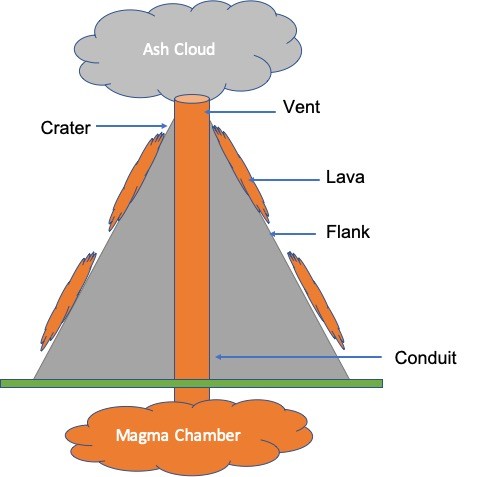
Image 1 – Anatomy of Volcano
There are primarily 5 parts of a volcano:
- Magma Chamber – It is a reservoir that contains molten magma and gases. It is the source of lava (magma) that is spewed out of a volcano.
- Conduit – During the eruption, magma and the gases move through a pipe called the Conduit towards the surface. There can be multiple conduits that are like branches of the main conduit.
- Flank – The slope or side of a volcano is called a flank. The flank structure is based on the type of volcanic eruptions and the material that is expelled. Slow-moving lava creates a gradual slope, while severe eruptions cause steep slopes.
- Vent – The vent is the opening at the top of the volcano from where eruption happens. The magma and the gases are expelled via this opening. A volcano can have multiple vents, but they have only a single center/primary vent.
- Crater – A bowl-shaped depression around the central vent is called Crater.
How are volcanoes formed: State of volcanoes
Once volcanoes are formed, they may exist as:
- Active – A Volcano that still erupts.
- Dormant – A volcano that does not erupt as often as the Active one and last erupted some years back. A dormant volcano may potentially erupt anytime.
- Extinct – A volcano that erupted a long time back and will not erupt in the future.
Classification of volcanoes formed
The volcanoes formed are classified based on the nature of the eruption and their physical structure.
Shield Volcanoes
These are the largest among the different types of volcanoes. The Shield volcanoes are like a shield of a warrior. The magma or the lava that erupts from this kind of volcano is low in viscosity (not thick). Also, it is less intense and the eruption is more or less like a fountain. Due to the less viscosity, these volcanoes have a gradual slope. Shield volcanoes fall under the category of Hotspots or Divergent Boundary.
The second-largest shield volcano after Pūhāhonu (in Hawaii) is the Mauna Loa volcano in Hawaii Islands.
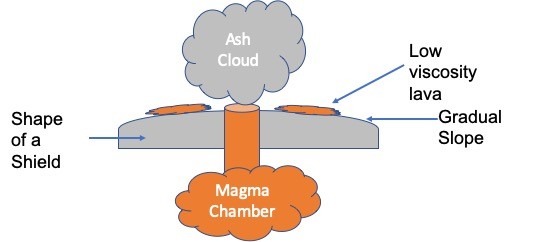
Image 2 – Shield Volcano
Composite Volcanoes or Stratovolcano
A Stratovolcano or composite volcano is a conical volcano that is built out of many layers of hardened lava, tephra, pumice, and ash.
Stratovolcanoes are steep when compared to shield volcanoes. The lava that erupts in this type of volcano is highly viscous, enough to form a hardened layer. Due to viscosity, the lava travels slow and does not cover large distances as it gets cooled quickly. The eruption part of this volcano is explosive.
Stratovolcanoes are mostly found along the convergent boundary.
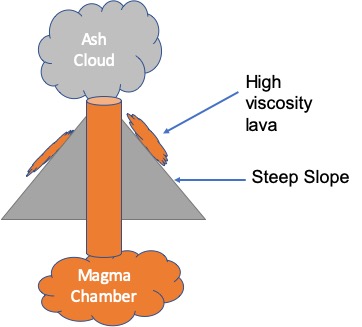
Image 3 – Stratovolcano
Caldera Volcanoes
The Caldera volcanoes are one of the most explosive volcanoes on Earth. The eruption is so explosive that all the magma in the magma chamber gets expelled. Due to the intensity and nature of the eruption, the magma chamber empties and collapses creating a huge depression. This depression is called Caldera. There are no tall flanks as is the case in stratovolcano or other volcanoes.
The high intensity of the eruption indicates that Magma Chamber in Caldera volcanoes is supposedly huge and is also in close vicinity to the vent. This small distance actually makes sense because if the distance between the chamber and the vent was large, due to gravity, the eruption would not be highly intensive.

Image Source – Wikipedia
Cinder Cone Volcanoes
Cinder cone volcanoes formed are short and steep. They have a single vent and are composed of volcanic ash and dark volcanic rocks called Scoria and Pyroclastic. The Magma that erupts from this type of volcano is highly viscous.
The explosion from the cinder cone volcano is highly intense. The emission cools down quickly and breaks into particles called cinders. These volcanoes are steep, have a flat top, and big circular Crater.
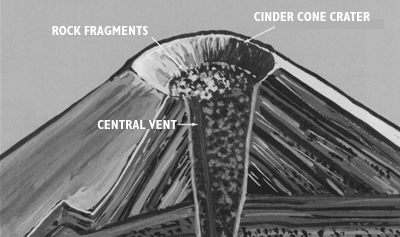
Image Source – Wikipedia
Compound or Complex Volcanoes
Compound volcanoes have many features. They have high towering peaks and generally contain two or more vents. There can also be volcanic domes on the flanks.
Supervolcanoes
Supervolcanoes are expected to have large depression or Caldera. These volcanoes are the most explosive and dangerous out of various volcanoes and can cause devastation on a very large scale (even Continental level). The eruption from such volcanoes can impact the temperature of the environment for many years because of the amount of sulfur that is thrown out.
The outcome of volcano eruptions
When a volcano eruption takes place, based on the type of eruption, there can be multiple outcomes:
- One negative outcome that we already highlighted in the introduction is the damage that erupted lava causes to the environment.
- One of the good things that volcano eruption brings to the table is the volcanic ash which is rich in nutrients (minerals) and thus is useful for the plants and the soil. There are countries where people live near the volcano and make use of the rich soil for agriculture.
Volcano eruptions over the years have created mountain ranges, islands, continents, and more. Let us focus on this point.
Mid Ocean Ridge
A mid-ocean ridge is a chain of an underwater mountain range covering every ocean on Earth. These are formed due to the movement of the tectonic plates along the divergent boundary.
When the plates move away from each other the magma from the mantle rises to the surface of the ocean floor. As the magma cools down, a new ocean floor and mountain ranges (ridges) are created. This rising of the magma towards the ocean floor is the volcanic eruption. Basalt which is the most common rock on Earth is what is expelled as part of the eruptions.
Almost 60,000 kilometers long, the mid-ocean ridge is the largest mountain range on Earth. This pull of the tectonic plates and the creation of new landmass underwater is what also causes continents to separate. The underwater volcanic eruptions can lead to a tsunami which is another natural disaster.
Flood Basalt Provinces
Flood Basalt Provinces are created when a high volume of lava consisting majorly of Basalt erupts and flows to thousands of kilometers. Because of this, new terrain and landmass are created. Flood Basalt Provinces are also referred to as traps.
Measurement of volcano eruptions
The volcanic eruptions are measured as per the Volcanic Explosivity Index (VEI). Measuring volcanic eruptions is not an easy job. Various elements are expelled, the duration of eruption is varied, and different topographies are created.
The Volcanic Explosivity Index (VEI), developed in 1982, is a relative scale that compares volcanic eruptions of different intensities. The type of elements (Pyroclastic Material – volcanic ash, tephra, etc.) that are expelled during the eruptions are the key to measure the intensity. The height of the explosion and the duration are also considered part of the measurement.
- The VEI scale starts with 0 which is related to when less than 0.0001 cubic kilometers of pyroclastic material is produced.
- Eruptions measured as VEI 1 are expected to produce pyroclastic material between 0.0001 to 0.001 cubic kilometers. So, a volcanic eruption that is measured as VEI 1 is 10 times more powerful than VEI 0, and so on.
- Above VEI 1, the scale becomes logarithmic.
- The maximum VEI that has been known till now is 8 (Example – Wah Wah Springs eruption in Utah some more than 30 million years ago). These eruptions have been assumed to produce 1000 cubic kilometers of pyroclastic material.
Comparison of Frequency of volcano eruptions and Volcanic Explosivity Index
| Volcanic Explosivity Index (VEI) | Frequency |
|---|---|
| 0 | Frequent |
| 1 | Frequent |
| 2 | Several per year |
| 3 | Tens per year |
| 4 | Tens per decade |
| 5 | One per decade |
| 6 | Several per century |
| 7 | Several per millennium |
| 8 | Two per 100,000 years |
Source – Geology.com
Some popular Volcanoes formed around the world and their current state
Following is a list of some of the Volcanoes around the world with their type and states:
| Volcano Name | Location | Classification Type | State |
|---|---|---|---|
| Mauna Loa | United States | Shield | Active |
| Fuji | Japan | Stratovolcano | Active |
| Pūhāhonu | United States | Shield | Extinct |
| Akademia Nauk | Russia | Caldera | Active |
| Mayon | Philippines | Stratovolcano | Active |
| Mount St. Helens | United States | Stratovolcano | Active |
| Popocatepetl | Mexico | Stratovolcano | Active |
| Arenal | Costa Rica | Stratovolcano | Active |
| Mount Semeru | Indonesia | Stratovolcano | Active |
| Mount Kilmanjaro | Tanzania | Stratovolcano | Dormant |
| Etna | Italy | Stratovolcano | Active |
| Bagana | Papua New Guinea | Cinder Cone | Active |
| Taal | Philippines | Complex Volcano | Active |
Some of the Deadliest Volcanic Eruptions
| Volcano | Location | Death Toll | Year |
|---|---|---|---|
| Mount Tambora | Indonesia | 71,000 to 250,100+ | 1815 |
| Krakatoa | Indonesia | 36,000+ | 1883 |
| Mount Palee | Martinique | 30,000 | 1902 |
| Nevado del Ruiz | Colombia | 23,000 | 1985 |
| Mount Unzen | Japan | 15,000 | 1792 |
Source – Wikipedia
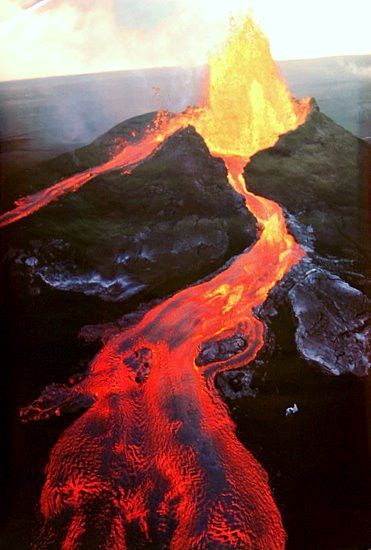
Image Source – Pinterest
Conclusion
That is the wrap-up. I hope you would have enjoyed the article. Let me know your comments i the comments section below.
Do share and like if you found the article informational.
Good Reads & References
CURATED & WRITTEN BY
AYUSH PANDYA
(AUTHOR – THE UNPRECEDENTED CULT)